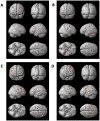Working memory-related functional brain patterns in never medicated children with ADHD
- PMID: 23166657
- PMCID: PMC3498108
- DOI: 10.1371/journal.pone.0049392
Working memory-related functional brain patterns in never medicated children with ADHD
Abstract
Attention Deficit/Hyperactivity Disorder (ADHD) is a pervasive neurodevelopmental disorder characterized by 3 clusters of age-inappropriate cardinal symptoms: inattention, hyperactivity and impulsivity. These clinical/behavioural symptoms are assumed to result from disturbances within brain systems supporting executive functions including working memory (WM), which refers to the ability to transiently store and flexibly manipulate task-relevant information. Ongoing or past medications, co-morbidity and differences in task performance are potential, independent confounds in assessing the integrity of cerebral patterns in ADHD. In the present study, we recorded WM-related cerebral activity during a memory updating N-back task using functional Magnetic Resonance Imaging (fMRI) in control children and never medicated, prepubescent children with ADHD but without comorbid symptoms. Despite similar updating performance than controls, children with ADHD exhibited decreased, below baseline WM-related activation levels in a widespread cortico-subcortical network encompassing bilateral occipital and inferior parietal areas, caudate nucleus, cerebellum and functionally connected brainstem nuclei. Distinctive functional connectivity patterns were also found in the ADHD in these regions, with a tighter coupling in the updating than in the control condition with a distributed WM-related cerebral network. Especially, cerebellum showed tighter coupling with activity in an area compatible with the brainstem red nucleus. These results in children with clinical core symptoms of ADHD but without comorbid affections and never treated with medication yield evidence for a core functional neuroanatomical network subtending WM-related processes in ADHD, which may participate to the pathophysiology and expression of clinical symptoms.
Conflict of interest statement
Figures



Similar articles
-
Working memory training restores aberrant brain activity in adult attention-deficit hyperactivity disorder.Hum Brain Mapp. 2020 Dec;41(17):4876-4891. doi: 10.1002/hbm.25164. Epub 2020 Aug 19. Hum Brain Mapp. 2020. PMID: 32813290 Free PMC article. Clinical Trial.
-
Working memory related functional connectivity in adult ADHD and its amenability to training: A randomized controlled trial.Neuroimage Clin. 2024;44:103696. doi: 10.1016/j.nicl.2024.103696. Epub 2024 Nov 2. Neuroimage Clin. 2024. PMID: 39536524 Free PMC article. Clinical Trial.
-
Regional brain activation changes and abnormal functional connectivity of the ventrolateral prefrontal cortex during working memory processing in adults with attention-deficit/hyperactivity disorder.Hum Brain Mapp. 2009 Jul;30(7):2252-66. doi: 10.1002/hbm.20665. Hum Brain Mapp. 2009. PMID: 19107748 Free PMC article.
-
[Structural and functional neuroanatomy of attention-deficit hyperactivity disorder (ADHD)].Encephale. 2009 Apr;35(2):107-14. doi: 10.1016/j.encep.2008.01.005. Epub 2008 Jul 7. Encephale. 2009. PMID: 19393378 Review. French.
-
Heterogeneity in brain functional changes of cognitive processing in ADHD across age: A systematic review of task-based fMRI studies.Behav Brain Res. 2021 Jan 15;397:112888. doi: 10.1016/j.bbr.2020.112888. Epub 2020 Sep 1. Behav Brain Res. 2021. PMID: 32882284
Cited by
-
Complex systems representing effective connectivity in patients with Type One diabetes mellitus.PLoS One. 2018 Nov 29;13(11):e0208247. doi: 10.1371/journal.pone.0208247. eCollection 2018. PLoS One. 2018. PMID: 30496324 Free PMC article.
-
Attention-deficit/hyperactivity disorder: An integrated developmental psychopathology and Research Domain Criteria (RDoC) approach.Compr Psychiatry. 2019 Apr;90:65-72. doi: 10.1016/j.comppsych.2018.12.016. Epub 2019 Jan 9. Compr Psychiatry. 2019. PMID: 30743139 Free PMC article. Review.
-
Genetic effects on the cerebellar role in working memory: same brain, different genes?Neuroimage. 2014 Feb 1;86:392-403. doi: 10.1016/j.neuroimage.2013.10.006. Epub 2013 Oct 12. Neuroimage. 2014. PMID: 24128737 Free PMC article.
-
Mapping cognitive brain functions at scale.Neuroimage. 2021 May 1;231:117641. doi: 10.1016/j.neuroimage.2020.117641. Epub 2020 Dec 15. Neuroimage. 2021. PMID: 33338609 Free PMC article.
-
A preliminary study of the effects of working memory training on brain function.Brain Imaging Behav. 2016 Jun;10(2):387-407. doi: 10.1007/s11682-015-9416-2. Brain Imaging Behav. 2016. PMID: 26138580 Free PMC article.
References
-
- Polanczyk G, Rohde LA (2007) Epidemiology of attention-deficit/hyperactivity disorder across the lifespan. Curr Opin Psychiatry 20: 386–392. - PubMed
-
- Wilens TE, Biederman J, Spencer TJ (2002) Attention deficit/hyperactivity disorder across the lifespan. Annu Rev Med 53: 113–131. - PubMed
-
- Willcutt EG, Doyle AE, Nigg JT, Faraone SV, Pennington BF (2005) Validity of the executive function theory of attention-deficit/hyperactivity disorder: a meta-analytic review. Biol Psychiatry 57: 1336–1346. - PubMed
-
- Baddeley A (2003) Working memory: looking back and looking forward. Nat Rev Neurosci 4: 829–839. - PubMed
-
- Gevins A, Smith ME (2000) Neurophysiological measures of working memory and individual differences in cognitive ability and cognitive style. Cereb Cortex 10: 829–839. - PubMed
Publication types
MeSH terms
LinkOut - more resources
Full Text Sources
Medical
Miscellaneous

